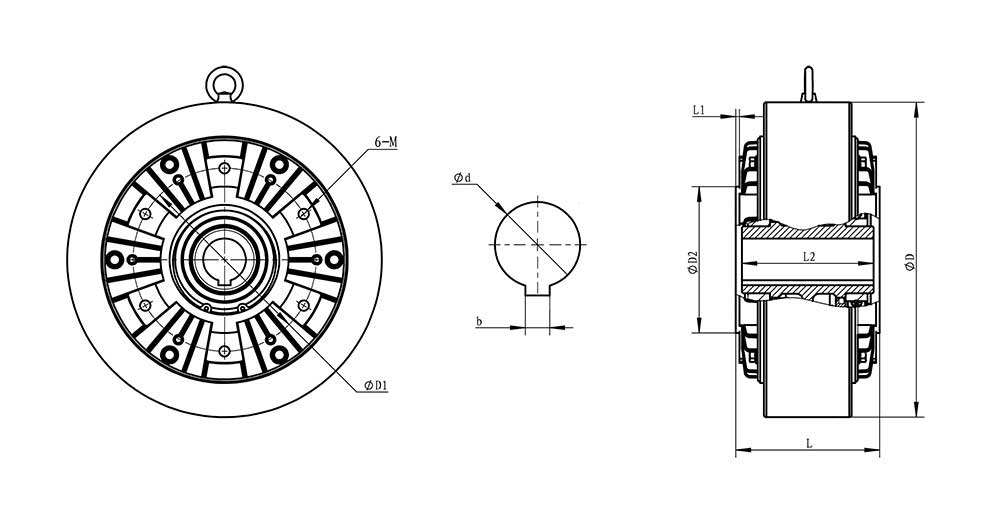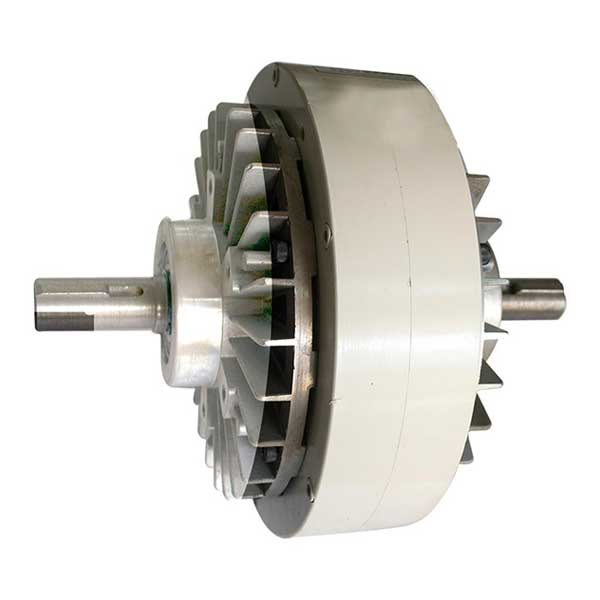As a tension control system for unwinding in the winding system, the magnetic particle brake can output a large braking torque and slip power when working, so it is widely used in web offset printing machines. During the production process, the magnetic particle brake can continuously adjust the tension of the paper in a large range to ensure the stability and continuity of the paper running process.

Self-cooling magnetic particle brake
The self-cooling magnetic particle brake uses magnetic particles to transmit torque according to the electromagnetic principle and has the characteristics that the excitation current and the transmitted torque are basically in a linear relationship. The magnetic particle brake can transfer a certain torque in the case of nothing to do with the slip and has the advantages of fast response, simple structure, no pollution, no noise, no impact vibration, energy saving, etc. It is a multi-purpose and superior-performance automatic brake. control element.
Pros of self-cooled magnetic particle brakes compared to water-cooled magnetic particle brakes
Most of the web offset printing machines in the 1990s used water-cooled magnetic particle brakes as the paper tension control system. The water-cooled magnetic particle brake is a brake that uses a circulating water system to cool the brake. With the technical improvement of printing machine manufacturers and the feedback and suggestions of printing units, self-cooling magnetic particle brakes have been widely used in web offset printing machines.
The self-cooling magnetic particle brake relies on its supporting heat sink or radiator to cool the brake naturally.
Five points of self-cooled magnetic particle brakes better than water-cooled magnetic particle brakes
Compared with water-cooled magnetic particle brakes, self-cooled magnetic particle brakes have the following five advantages:
- Purified water sources and water pumps without forced cooling save printing machine space and reduce production consumption.
- The circulating water circuit is canceled to avoid magnetic particle sintering caused by cooling water leakage.
- The aluminum alloy shell with good heat dissipation performance is adopted, which has good heat dissipation performance and long service life of the magnetic particles.
- The control power is smaller and the braking torque is larger.
- The structure is simple, the weight is light, and the installation is more convenient.
Structure of self-cooling magnetic particle brake
Self-cooling magnetic particle brake is mainly composed of a rotor shaft, inner stator, coil, shell, and magnetic particle. The front end of the rotor shaft is connected to the input shaft on the paper feeder, and the rear end is connected to the casing. The coil is installed in the annular groove of the inner stator and sealed. The inner stator is fixed on the rotor shaft through bearings, and its front end is fixed on the paper feeder. The magnetic particle is distributed in the annular space between the inner stator and the casing (the gap between the inner stator and the casing is small). When the roll paper is running, the inner stator of the brake does not move, the casing rotates, and the heat during operation is taken away by the cooling fins on the casing.
Working principle of self-cooling magnetic particle brake
After the excitation current is passed into the coil, a magnetic flux circuit is generated in the magnetic particle brake, which makes the magnetic particle magnetized in a chain shape, and combines with the inner stator contact surface and the housing contact surface. Their combined friction produces a slip torque on the rotor shaft. As the input current increases, the torque increases accordingly. By adjusting the magnitude of the excitation current, the slip torque of the magnetic particle brake can be adjusted. After the excitation current is cut off, the magnetic flux in the magnetic particle brake disappears. The magnetic particle is in a loose state and cannot generate slip torque on the rotor shaft.
Three types of troubleshooting for magnetic particle brakes
The magnetic particle brake is stuck
- Cause Analysis: Vibration during transportation or prolonged storage causes the magnetic particle in the brake to scatter aside;
The magnetic particle is added too much; the concentricity of the rotor shaft is not enough, resulting in uneven output torque and jamming; the use of inferior magnetic particles. - Solution: Before operation or after the device is moved, a run-in operation must be carried out to distribute the magnetic particle evenly: quantitatively use a qualified special magnetic particle: and check and repair the rotor shaft.
The rotation resistance of the magnetic particle brake becomes larger and makes a lot of noise
- Cause Analysis: Corroded or damaged rotor shaft bearings.
- Solution: Check or replace bearings.
The output torque of the magnetic particle brake drops or the performance is unstable
- Cause Analysis: The magnetic particle is aging; the magnetic particle is damp and hardened; the work required torque exceeds the rated torque of the brake.
- Solution: Check or replace the magnetic particle; replace the appropriate magnetic particle brake.
Performance comparison between magnetic particle brake and electromagnetic brake
Performance characteristics of an electromagnetic brake
- Simple structure and easy installation:
- Easy to operate;
- Large tension adjustment range;
- Sensitive tension control and quick response;
- There are many supporting devices for the brake;
- Tension control is easily affected by pressure changes in the gas system;
- The friction plate and electromagnetic coil seat are easy to wear.
Performance characteristics of magnetic particle brake
- Easy to operate;
- Stable tension control:
- Long brake life:
- The tension adjustment range is small;
- It is difficult to replace the magnetic particle.
Read More: Magnetic particle clutch Wikipedia
